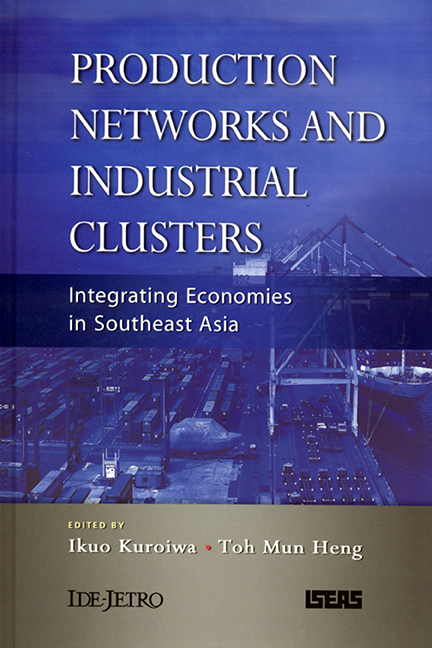Book contents
- Frontmatter
- Contents
- List of Tables
- List of Figures
- Preface
- Acknowledgements
- Contributors
- 1 Introduction
- I Overview of the Production Networks and Industrial Clusters in Southeast Asia
- 2 The Mechanics of Production Networks in Southeast Asia: The Fragmentation Theory Approach
- 3 Cross-Border Production Networks in Southeast Asia: Application of the International Input-Output Analysis
- 4 Industrial Clusters and Production Networks in Southeast Asia: Global Production Network Approach
- II Case Studies
- III Drivers for the Expanding Production Networks
- Index
3 - Cross-Border Production Networks in Southeast Asia: Application of the International Input-Output Analysis
from I - Overview of the Production Networks and Industrial Clusters in Southeast Asia
Published online by Cambridge University Press: 21 October 2015
- Frontmatter
- Contents
- List of Tables
- List of Figures
- Preface
- Acknowledgements
- Contributors
- 1 Introduction
- I Overview of the Production Networks and Industrial Clusters in Southeast Asia
- 2 The Mechanics of Production Networks in Southeast Asia: The Fragmentation Theory Approach
- 3 Cross-Border Production Networks in Southeast Asia: Application of the International Input-Output Analysis
- 4 Industrial Clusters and Production Networks in Southeast Asia: Global Production Network Approach
- II Case Studies
- III Drivers for the Expanding Production Networks
- Index
Summary
INTRODUCTION
In East Asia, cross-border production sharing, where stages of production leading up to final goods are fragmented and allocated to various countries epending on comparative advantages, has been a driving force of economic integration. As shown in other chapters in this volume, production networks have expanded significantly due to a major reduction in transport and communication costs across borders.
As production sharing accelerates, an industry becomes more dependent on parts and components supplied by partner countries in its production network. Then it is expected that a percentage of imported inputs, especially from a partner country, will increase, so that import content may rise (or local content may decline) accordingly. However, there are other forces which operate in the opposite direction. For example, if strong from the domestic suppliers may increase, and local content would be affected accordingly. Yet, since the forces which further fragment production will remain at work — especially when there is a significant difference in production costs across border — there may be a variety of patterns in procurement of inputs depending on the nature of the industry.
In this study, the Asian International Input-Output Tables (the Asian Tables hereafter) for 1990 and 2000 are utilized to examine changes in trade structure and procurement of inputs — local content as well as import content — in East Asia. Further, spatial linkages, which are shaped by transactions of inputs across border, are analysed. Finally the factors affecting these changes are considered from the viewpoint of the nature of the industry, especially characteristics of parts and components and industrial policy.
In this study, five ASEAN countries — Indonesia, the Philippines, Thailand, Malaysia, and Singapore — are the main focus and are compared with three Northeast Asian economies: China, Korea, and Taiwan. Further, Japan and the U.S. are included as endogenous countries in the Asian Tables2 and appear in each table or figure as trade partners for the eight East Asian economies.
This chapter is structured as follows: first, changes in the trade structure and intra-industry trade in 1990–2000 are discussed. Second, the input structures of the manufacturing sector, especially those of the electronics and automotive sectors, are explored by applying the decomposition analysis of international input-output tables. Third, spatial linkages of the electronics and automotive industries are presented. Finally, factors affecting the changes in local content are discussed.
Information
- Type
- Chapter
- Information
- Production Networks and Industrial ClustersIntegrating Economies in Southeast Asia, pp. 54 - 85Publisher: ISEAS–Yusof Ishak InstitutePrint publication year: 2008
